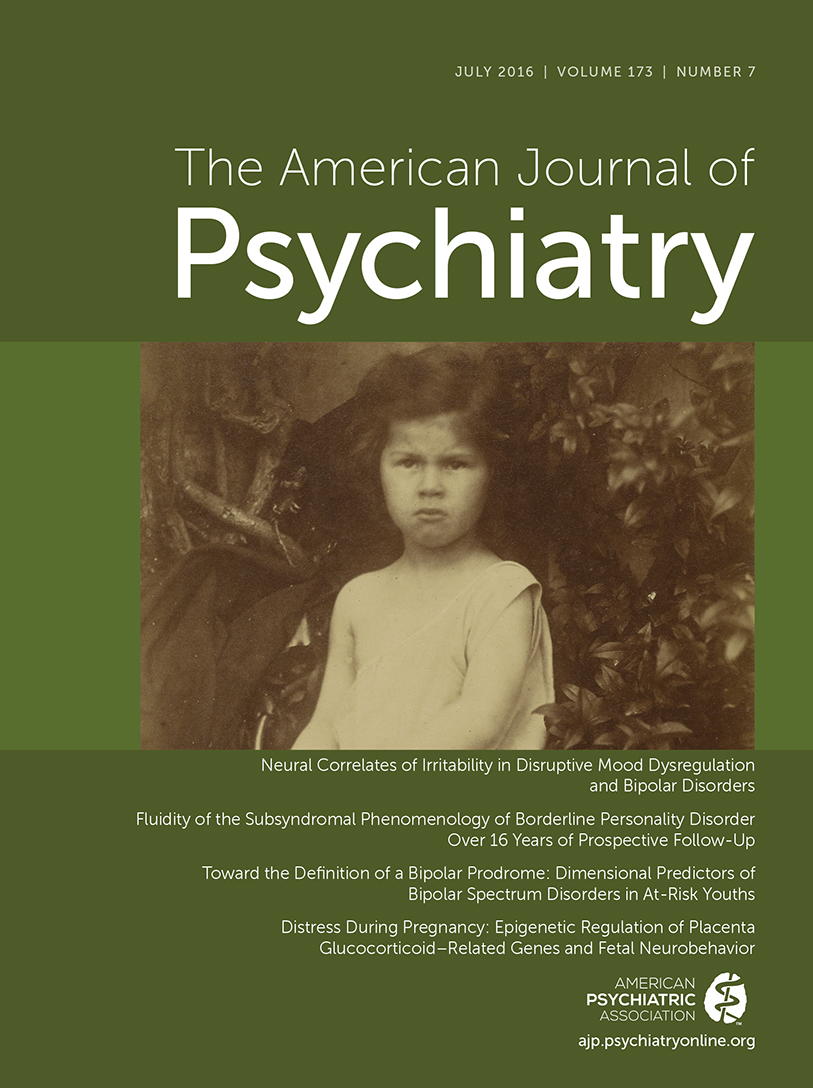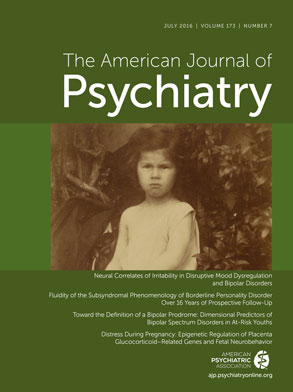Irritability and aggression resulting from it are the most common reasons that children are brought in for psychiatric evaluation, accounting for more than 40% of emergency department psychiatric evaluations and more than 20% of pediatric outpatient psychiatric evaluations (
1–
4). Moreover, childhood irritability is associated with significant impairment in youth and adulthood, including school problems, reduced financial attainment, psychopathology, and suicide (
2,
5,
6). Thus, irritability in children is among the most common and impairing mental health symptoms affecting people, regardless of their age.
Despite our knowledge about the importance and impact of childhood-onset irritability, large gaps remain. Among the most problematic unknowns is the fact that although irritability is an explicit diagnostic criterion or associated symptom for multiple DSM diagnoses, there is no well-validated marker (scale, test, scan, or gene) to guide clinicians in determining what disorder or disorders involving irritability a particular child has—let alone what the child’s risk is of developing related disorders in the future.
Irritability is an explicit DSM diagnostic criterion in patients regardless of age for a manic episode in bipolar disorder, generalized anxiety disorder, and posttraumatic stress disorder. It is a child-specific modification to the criteria for major depressive episode. In DSM-5, irritability is an explicit criterion for oppositional defiant disorder, whereas it was implied, but not stated, in previous editions of DSM. Also in DSM-5, chronic irritability without euphoria or other bipolar symptoms is now part of a new diagnosis, disruptive mood dysregulation disorder (DMDD). Irritability is an associated feature of attention deficit hyperactivity disorder and autism spectrum disorder. Obviously, the multiplicity of psychiatric diagnoses involving irritability is a complicated problem. However, addressing it requires that we develop a greater understanding of the mechanisms of pediatric irritability through research on brain, behavior, symptoms, and genetics, plus longitudinal studies to determine the trajectories of irritability as it evolves from childhood into adulthood and to distinguish pathological/impairing irritability from that of typical development (
7,
8).
Toward that end, in this issue of the
Journal, Wiggins et al. (
9) seek to advance what is known about the neural underpinnings of emotional face labeling—among the most basic aspects in the complicated process of emotion regulation—in two mutually exclusive groups of children and adolescents with irritability plus typically developing healthy comparison youths (without psychiatric illness).
For the two groups of irritable youths, the authors followed the approach of Leibenluft (a coauthor of the study), designed to address controversies surrounding childhood-onset bipolar disorder: In one group, they enrolled youths with “narrow phenotype bipolar disorder” who met a strict interpretation of DSM criteria for bipolar disorder, including having distinct episodes lasting ≥4 days (hypomania) or ≥7 days (mania) of elevated, expansive mood (“euphoria”) accompanied by sufficient criterion B symptoms. In the other group, they enrolled youths meeting the DSM-5 criteria for DMDD who had a chronic nonepisodic course of functionally impairing irritability. Irritability often accompanies euphoria in narrow-phenotype bipolar youths, but its presence alone, without euphoria, would be exclusionary (
10). Similarly, youths with DMDD cannot have had a distinct period of more than 1 day with symptoms of mania, such as euphoria. Leibenluft’s operationalizing criteria for children with episodic euphoria versus chronic irritability and for comparing the brain/behavior mechanisms and longitudinal course have powerfully advanced our understanding of childhood-onset irritability, including by demonstrating that chronic irritability in childhood is often associated with unipolar major depressive disorder in adulthood, whereas episodic euphoria in childhood is associated with mania in adulthood, findings that ultimately led to DMDD’s inclusion in DSM-5 (
2,
5).
Wiggins and colleagues’ primary finding is that while youths with DMDD and bipolar disorder had similar levels of parent-reported irritability symptoms and did not differ in their behavioral accuracy in identifying emotional faces, they differed in the relationship between irritability symptoms and neural activity. While neural activity in the amygdala in the DMDD group correlated with irritability symptoms across all intensities of all emotions, amygdala neural activity in the bipolar group correlated with irritability only in responses to fearful faces. These group-specific symptom/circuit associations suggest the need for different treatments to address irritability in youths with bipolar disorder and those with DMDD.
In a second article in this issue, Hafeman et al. (
11) seek to identify dimensional symptom predictors of new-onset bipolar spectrum disorder among youths ages 6–18 who are at familial increased risk of bipolar disorder. At baseline, among 391 offspring of parents with type I and II bipolar disorder, 8.4% (N=33) had bipolar spectrum illness. After 8 years of follow-up, 14.7% (N=44/299) had new-onset bipolar spectrum illness (15 of them with bipolar I or II disorder).
At baseline, at-risk and bipolar offspring had higher levels of anxiety/depression, inattention/disinhibition, externalizing symptoms, affective lability, and subsyndromal manic symptoms. The strongest predictors of developing bipolar disorder were baseline anxiety/depression, baseline and proximal affective lability, and proximal subsyndromal manic symptoms, with those having all risk factors having a 49% predicted chance of developing bipolar spectrum symptoms, compared with a 2% risk for those without. This finding supports the importance of tracking such dimensional symptom measures.
Taken together, the articles by Wiggins et al. and Hafeman et al. move the field forward by tackling, with different techniques, the need for a greater understanding of the mechanisms of irritability in children and adolescents, including how to differentiate abnormal, functionally impairing irritability in specific clinical presentations from that seen in typically developing youths.
Moreover, both studies seek to identify children and adolescents who have early signs of irritability that will subsequently cause substantial impairment. Whether such early recognition and treatment can successfully avert this trajectory from sparks to forest fire is clearly a question that needs to be addressed.
Ultimately, childhood irritability is a not a problem germane only to those working in mental health or those working exclusively with children, because its effects persist into adulthood and affect all aspects of a person’s health—not just mental health. Addressing the problem of childhood irritability will require true partnerships and collaborations between patients and parents, and between clinicians and researchers, regardless of their disciplines or specialties, and regardless of where in the lifespan—from childhood through adulthood—they work.

